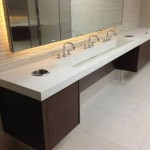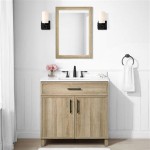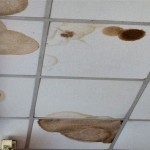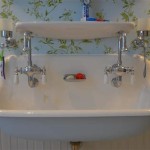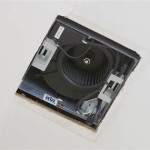How To Get Drawers Out Of A Bathroom Vanity
Removing drawers from a bathroom vanity can be a necessary task for various reasons, ranging from routine cleaning and maintenance to plumbing repairs and even full vanity replacement. Understanding the mechanisms that secure drawers within the vanity frame is crucial to avoid damage to either the drawer itself or the vanity structure. Different manufacturers employ different drawer slide systems, and familiarity with these systems will streamline the process and prevent unnecessary frustration.
This article will offer a comprehensive overview of the common drawer slide mechanisms found in bathroom vanities and provide step-by-step instructions for safely removing drawers. It will also cover troubleshooting tips for situations where the drawers are stuck or the release mechanism is not immediately apparent. By carefully following these guidelines, homeowners can confidently remove and reinstall their bathroom vanity drawers without causing damage.
Identifying the Drawer Slide Mechanism
The first step in removing a drawer is to identify the type of drawer slide system used. This will dictate the removal process. Common types include: side-mounted slides (which are the most prevalent), center-mounted slides, and undermounted slides. Each type requires a specific approach to release the drawer from the slide hardware.
Side-Mounted Slides: This type of slide is visible along the sides of the drawer box when the drawer is fully extended. They typically consist of two metal or plastic components, one attached to the drawer and the other to the inside of the vanity cabinet. Side-mounted slides can feature a variety of release mechanisms, including levers, clips, or friction releases.
Center-Mounted Slides: Center-mounted slides are located underneath the center of the drawer. They are attached to the bottom of the drawer box and run along a rail fixed within the vanity cabinet. These slides often utilize a simple friction release, but some may incorporate a latch or lever.
Undermounted Slides: Undermounted slides are concealed beneath the drawer box. They are characterized by a pair of metal slides attached to the sides of the vanity cabinet and a locking mechanism that connects to the bottom of the drawer. Removing drawers with undermounted slides usually involves disengaging these locking mechanisms.
Examining the drawer slides closely while the drawer is fully extended will allow for proper identification. Look for any levers, clips, buttons, or unusual mechanisms on the slides. If the slides are obscured, using a flashlight can help illuminate the area. Consulting the vanity manufacturer's manual, if available, is also a good resource for identifying the type of slide used and its corresponding removal procedure.
Removing Drawers with Side-Mounted Slides
Side-mounted slides are arguably the most common and diverse in terms of release mechanisms. However, most follow a similar principle of disengaging the drawer slide from the cabinet slide. Here’s a breakdown of common release methods:
Lever Release: These slides typically feature a plastic or metal lever positioned on either side of the drawer, near the front. To remove the drawer, fully extend it. Locate the levers on both the left and right drawer slides. Simultaneously depress or lift the levers (the direction may be indicated by an arrow or marking on the lever itself). While holding the levers in the disengaged position, gently pull the drawer straight out of the vanity cabinet.
Clip Release: Some side-mounted slides use clips instead of levers. These clips are usually located on the sides of the drawer, near the front. The drawer must be fully extended. Identify the clips on each side of the drawer. Push the clips inward, towards the center of the drawer, or outward, away from the drawer, depending on the design. While maintaining pressure on the clips, pull the drawer straight out.
Friction Release: These slides rely on friction to hold the drawer in place. There are no visible levers or clips. To remove the drawer, fully extend it. Firmly grasp the left and right sides of the drawer. Apply a steady, even pulling force while gently wiggling the drawer from side to side. The drawer should eventually slide free from the rails. Be cautious not to apply excessive force, as this could damage the slides or the drawer box.
Two-Piece Disconnect Style: Some older or basic slides employ a two-piece design, lacking a distinct release mechanism. To remove the drawer, fully extend it. Observe the rails on the sides. You may need to gently lift the drawer slightly as you pull it outward. This allows the rollers on the drawer portion of the slide to clear the track on the cabinet portion. Apply even pressure on both sides of the drawer to prevent binding. This can be a bit tricky to maneuver, as the alignment needs to be precise.
When reinstalling drawers with side-mounted slides, align the drawer slides with the corresponding cabinet slides and gently push the drawer inward until it clicks or locks into place. Ensure both sides are properly engaged before fully closing the drawer.
Removing Drawers with Center-Mounted Slides
The simplicity of center-mounted slides makes them relatively easy to remove. These slides, located underneath the drawer, typically use a friction-based or lever mechanism to secure the drawer.
Friction Release: For drawers with a friction release, fully extend the drawer. Locate the center-mounted slide underneath the drawer box. Grasp the drawer firmly on both sides. Apply a steady, even pulling force while gently wiggling the drawer from side to side. The friction between the slide and the rail will eventually release, allowing the drawer to slide out. If resistance is encountered, inspect the slide for any debris or obstructions that may be hindering its movement.
Lever Release: Some center-mounted slides incorporate a lever near the front of the slide. Fully extend the drawer. Locate the lever underneath the drawer. Depress the lever while simultaneously pulling the drawer straight out. Ensure the lever is fully disengaged before applying excessive force.
Reinstalling drawers with center-mounted slides involves aligning the slide with the rail inside the cabinet and pushing the drawer inward until it is fully seated. Ensure the drawer moves smoothly and is securely in place before closing it.
Removing Drawers with Undermounted Slides
Undermounted slides are typically found in higher-end bathroom vanities and offer a clean, concealed appearance. They utilize locking mechanisms that connect the drawer to the slides mounted on the inside of the vanity cabinet.
Lever or Latch Release: To remove drawers with undermounted slides, fully extend the drawer. Locate the locking mechanisms, which are usually small levers or latches located on the underside of the drawer, near the front or back, where the drawer box meets the slide hardware. These mechanisms may be on the left and right sides, or just one side.
Determine the orientation of the locking mechanism. Some levers need to be pushed inward, while others might require lifting or depressing. Disengage the locking mechanisms on both sides of the drawer, if applicable. While holding the mechanisms in the disengaged position, lift the drawer slightly to clear the slides and pull it straight out of the vanity cabinet. If only one latch is present, it may be linked to a mechanism that disengages both sides of the drawer.
Cam Lock Type: Some undermount slides utilize a cam lock mechanism. These are typically adjusted using a screwdriver. Looking underneath the drawer near the front, locate the cam lock. Rotate the cam lock with a screwdriver until the drawer releases from the slide hardware. This may require some trial and error to find the correct rotation direction.
Reinstalling drawers with undermounted slides requires careful alignment of the drawer with the slides. Ensure the locking mechanisms are fully engaged when pushing the drawer back into the vanity. Listen for a click sound, which indicates a secure connection. Test the drawer by opening and closing it to verify that it moves smoothly and is properly locked in place.
Troubleshooting Stuck or Difficult-to-Remove Drawers
Despite following the proper procedures, drawers may occasionally prove difficult to remove. Several factors can contribute to this, including misalignment, obstructions, and damaged slides. The following troubleshooting tips can help resolve these issues:
Check for Obstructions: Examine the drawer slides and the surrounding area for any obstructions, such as small objects, debris, or loose screws. These can interfere with the movement of the drawer and prevent it from releasing. Remove any obstructions before attempting to remove the drawer again.
Inspect for Misalignment: Misalignment of the drawer slides is a common cause of stuck drawers. Check if the slides are properly aligned with the frame of the vanity cabinet. If the slides are significantly misaligned, loosening the screws that secure them to the cabinet can allow for slight adjustments. Avoid overtightening the screws after making adjustments, as this can exacerbate the problem.
Lubricate the Slides: Applying a lubricant, such as silicone spray or dry graphite lubricant, to the drawer slides can reduce friction and facilitate smooth movement. Extend the drawer as far as possible and spray the lubricant onto the slides and rollers. Work the drawer back and forth several times to distribute the lubricant evenly.
Examine for Damage: Inspect the drawer slides for any signs of damage, such as bent metal, broken plastic components, or loose rollers. Damaged slides can prevent the drawer from releasing properly. Depending on the extent of the damage, it may be necessary to replace the entire drawer slide assembly.
Apply Even Pressure: When pulling the drawer, ensure that pressure is applied evenly to both sides. Uneven pressure can cause the drawer to bind and make it more difficult to remove. Position hands on each side of the drawer and pull with a steady, consistent force.
Consult the Manufacturer's Manual: If the drawer continues to resist removal, consult the vanity manufacturer's manual for specific instructions or troubleshooting tips. The manual may provide details about the drawer slide system and its removal procedure that are not readily apparent.
Seek Professional Assistance: If all other troubleshooting steps fail, consider seeking professional assistance from a handyman or cabinet maker. They have the experience and tools necessary to remove stuck drawers safely and efficiently without causing damage to the vanity.

Get Bathroom Cabinet Drawer Installation By The Dude

How To Build A Bathroom Vanity Sliding Shelf Interior Frugalista

Pull Out Drawers For Bathroom Cabinets A Quality Roll Outs

How To Cut And Modify Vanity Drawers For Plumbing Easy Diy Steps Abbotts At Home

Pull Out Drawers For Bathroom Cabinets A Quality Roll Outs

Bathroom Vanity Remove The Drawers

Bathroom Vanity Storage And Organization Ideas You Need

Rev A Shelf U Shape Under Sink Pullout Organizer Plumbing Cupboard Design Bathroom Organisation

How To Cut And Modify Vanity Drawers For Plumbing Easy Diy Steps Abbotts At Home
The Perfect Under Sink Organization Solution Thrifty Decor Diy And Organizing
Related Posts

